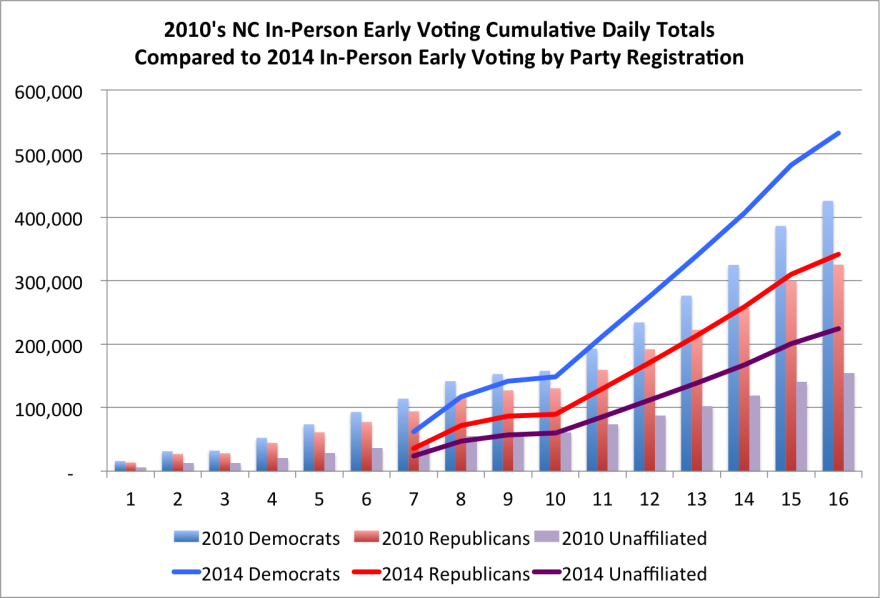Now that we have phase one of the voting process completed in North Carolina, namely the in-person early voting, all that we have to do is await the final results on Tuesday’s Election Day.
In 2008’s and 2012, 61 percent of the ballots cast came before Election Day, with thirty-eight percent coming in on Election Day.
But in 2010, only 35 percent of the ballots came before Election Day, while in 2006, only 21 percent came early.
But it seems like this year’s mid-term election in the Old North State is indeed very different from the two previous mid-term elections. First, a truly competitive statewide U.S. Senate race is driving much of the attention this year. In 2010, there was a U.S. Senate race, it wasn’t as competitive. In 2006, there were no statewide races.
Second, while the past two mid-term elections were more wave-like years (2006 was a national Democratic year, while 2010 was the GOP-Tea Party insurgency year), this year’s election doesn’t seem to be generating the anticipated rip current. Granted, the president’s party has to defend many more seats in the upper chamber of Congress, with the distraction of an unpopular president weighing on them. This is a typical sixth-year problem for most presidents and their parties.
But 2014 does seem a bit different, when looking at the 1.15 million early votes cast this year, which saw a 28 percent increase over 2010’s numbers of in-person early votes. First, the campaigns seemed to take into account the reduction in days, but not hours, of early voting.
With seven fewer days of voting, registered Democrats and unaffiliated voters reached their comparable in person same-day 2010 totals on the fifth day of this year’s early voting period; it took until the eighth day of early voting for registered Republicans to match their same-day in person 2010 totals.
In 2010, the ending percentages of in person early voting among the parties was 47 percent for registered Democrats, 36 percent for registered Republicans, and 17 percent for registered unaffiliated voters.
This year, registered Democrats are 48.5 percent, registered Republicans are 31 percent, and registered unaffiliated voters are 20 percent of this year’s in person early votes.
This year’s mid-term early electorate, using a party registration percentage basis, is more aligned to a presidential year: 2012 saw early voters 49 percent Democratic, 30 percent Republican, and 21 percent unaffiliated.
According to the State Board of Elections, registered Democratic turnout was up 3.8 percent compared to four years ago; registered unaffiliated turnout was up 1.5 percent, while Republican turnout was up only half-a-percent.
Along with party registration, it’s important to see how demographically the early voting electorate appears. In 2010, white voters were 77 percent of the early voters, while African-American voters were only 21 percent. In comparison, the 2012 in-person early voting electorate saw white voters as two-thirds to 30 percent of black voters.
This year’s mid-term election is 72 percent white and 25 percent black; black voters saw their numbers increase 45 percent, while white participation increased 13 percent. Black early-voting turnout was 19 percent, compared to 18 percent for white early-voting turnout.
Many had speculated “who would show up” in early voting this year: would it be repeat early in person voters, or would we see voters who hadn’t voted early cast their ballots during the early voting period?
In examining the voters and their voting records from four years ago, we see a distinct pattern among the party registration groups.

Among registered Democratic, but more importantly among registered unaffiliated voters who cast in person early ballots this year, significant pluralities did not vote in 2010. It could be they weren’t registered in 2010, not living in the state, or simply did not vote in the last mid-term.
There were over 75,000 voters who could have voted in 2010 but did not, and who voted this year: 54 percent of these voters are registered Democrats, 24 percent are registered Republicans, and 22 percent are registered unaffiliated.
Among registered Democrats who cast 2014 in-person early votes and were registered in 2010 but didn’t vote then, 54 percent are African-American voters, potentially signifying a ground game to organize and turn out a critical voting bloc for Democratic candidates, especially Kay Hagan.
Whether these new mid-term voters are significant enough to overcome the traditional GOP-lean in the state’s mid-term elections can only be evaluated after Tuesday’s vote. But the numbers do suggest a competitive battle on the ground, after an exhaustive air campaign.


